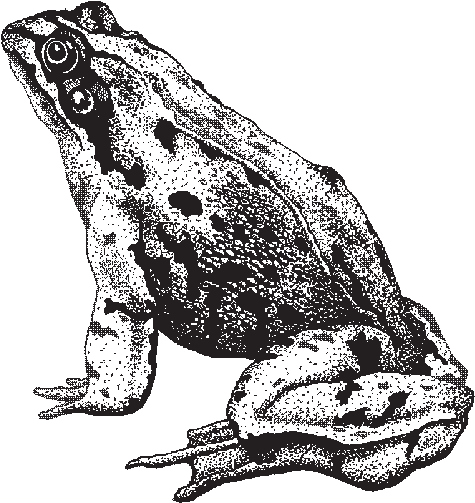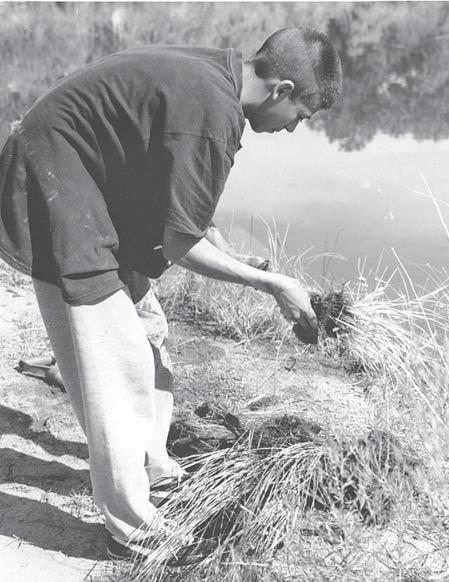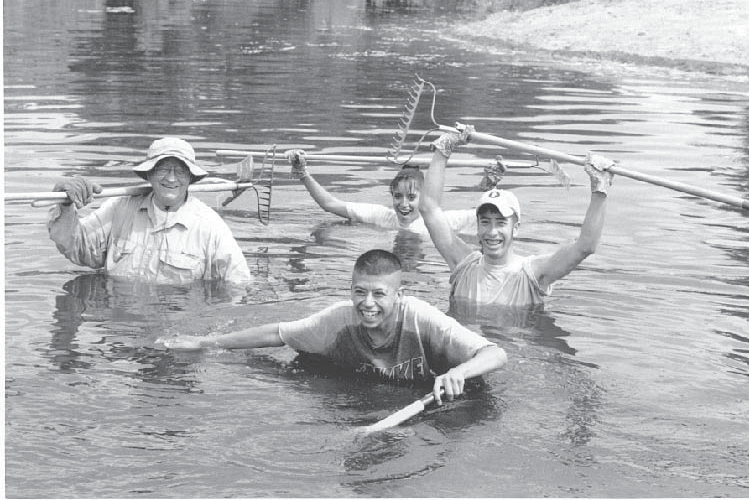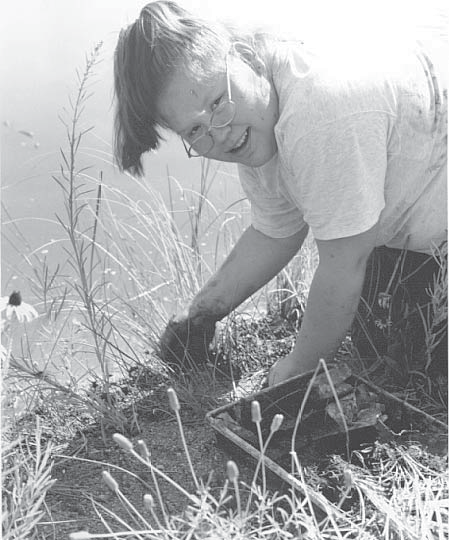The Museum is currently closed for rennovations. Updates on the renovation will be available through the link Renovation Updates as well as through the museum's social media.
You are here
Chapter 7: Living Like We Love It

Chapter 7: Living Like We Love It
Contents
- Service Learning in the Bosque
- On-the-Ground Service-Learning Projects
- Preparation for a Service-Learning Project
- Implementation of a Service-Learning Project
- Celebration of a Service-Learning Project
- Outreach-Oriented Service Learning
Service Learning and Outreach
This chapter explores the potential of making the bosque a focal point for service-learning opportunities. This chapter is intended to guide teachers toward helping their students participate in improving the bosque ecosystem. Research shows that when environmental education involves students in action efforts the students develop increased knowledge. Your students will also be empowered by the opportunity to help the bosque. This chapter is divided into two sections; the first provides information on traditional service-learning projects that include taking action in the woods, and the second section suggests ways students can share their knowledge of the bosque with other people.
Service Learning in the Bosque
An important step in effective environmental education is to encourage stu- dents to take action based on their newly acquired knowledge. As they learn about the bosque through field trip and classroom activities in this guide, students develop the idea that the present-day bosque needs human assistance to maintain ecological health. Involving students in a service-learning project in the bosque empowers students by allowing them to make a difference.
Service learning is a teaching method that engages students in service activities that are integrated into an academic curriculum. Students use academic skills they are learning in the classroom to conduct service projects, to meet actual community needs. Providing students with real-world applications for their academic skills allows them to recognize the value of what they are learning and increase their retention levels. The concept of using service as a tool for teaching required academic skills is what differentiates service learning from community service; the latter focuses exclusively on volunteerism. (In addition, the term “community service” has, in recent years, often been tied to court-mandated restitution for crimes.) Service-learning projects are carefully designed with student learning in mind, and are not merely cheap student labor. With service learning a sense of responsibility and caring is fostered by connections forged between students and the community, plus students are empowered by the ability to create positive change. Recent stud- ies have shown that by increasing students’ confidence and responsibility, service learning helps reduce truancy, dropout rates, violence, and apathy.
Each service-learning project consists of four essential steps: 1) preparation; 2) imple- mentation; 3) reflection; and 4) celebration. Preparation and planning are required to determine what type of service should be done and how it fits into the curriculum. More planning and revision will occur during the implementation phase because a real project is never identical to a written plan. Reflection activities such as discus- sion, journal writing, and artwork are important for students to process what they have learned and experienced. Projects culminate with a celebration to honor the students’ accomplishments. (Adapted from Service Learning in the Albuquerque Public Schools, Center for Service Learning, Montgomery Complex, 1998–1999.)
By involving students in action projects to preserve, sustain, and enhance the bosque (and its associated watersheds), our children, who are the future adult citizens, develop a sense of ownership and stewardship of the local environment. Another type of service-learning activity is for students to reach out to others to educate them about the bosque. This chapter is divided into two sections: on-the-ground projects and outreach projects. Additional information to support these sections can be found in the Resources for Bosque Education handout available at the Bosque Education Guide workshop.
On-the-ground Service-learning Projects
The bosque and the river itself are very important features in our ecosystem and therefore provide an ideal setting for service-learning projects. Any type of environmental topics can be related to bosque projects. Natural history and human impact on the river and bosque can be discussed through a variety of projects from a trash cleanup to pole planting.

The Rio Grande Nature Center State Park was the site of a service-learning project for Rio Grande High School students, including Alfonso Amaro, in 2000.
Service-learning projects, including activities as simple as trash cleanup, need to be coordinated with the appropriate local agency personnel. With service-learning projects, there are specific roles for students, teachers, and agency personnel. Students need background information about the problem and the project that is addressing the problem. Ideally, students develop this knowledge through active participation in the planning of the work project. If students have not been involved in the project plan, they need to be briefed in advance of the workday so they will know what they will be doing and why. Teachers need to form a partnership with the agency personnel they are working with to set up clear communications about goals and procedures. Teachers need to explain to agency personnel how the project ties in with student curriculum. Agency personnel should try to balance the needs of the teacher and the students with the needs of the agency. It may be useful for agency personnel to visit with students in their classroom to discuss the project prior to the work day.
There is no one right way to develop a service-learning project. Sometimes a project evolves from students identifying a problem, developing a solution, and then working with the agencies to implement that solution. More often, students or teachers contact the agencies to see if they have a project that they would like help implementing. There are several ways that students can assist with bosque projects. Below is a list and short descriptions of some of the more common bosque service-learning projects. Students and teachers should get specific instructions for implementing these projects from the agency personnel.
Pole planting is a method of reestablishing cottonwood trees by placing cut cottonwood poles or saplings (grown for this purpose) in the ground water. Projects take place during the late winter months (generally February to April) prior to tree buds leafing out. As adequate supervision is essential for tree survival, these projects are generally limited to smaller groups of students.
Trash cleanup is essential to keeping the bosque clean and safe. Safety is essential in this activity (see guidelines under Safety). This is a relatively simple activity to plan and execute and is recommended for large groups of any age including younger students.
Seed ball making and distribution is one method of disseminating grass and herb seeds into an area. This is an excellent activity for teaching about the importance of native plants. Seeds are mixed with mud and made into mud balls, which is a totally enjoyable activity, especially for younger students. Once the mud balls harden, they are distributed in areas where native seed sources are lacking and yet native plants are desired.
Reseeding large areas with grass and wildflower seed is another way to reintroduce native plants into an area where natural seed sources are marginal, such as sites of catastrophic fires. This activity is generally suitable for medium-size groups (large groups if there is adequate supervision) of any age group.
Fuel-wood removal of dead limbs on the ground involves moving logs and limbs out of the bosque. If left in the bosque, these materials make wildfires burn hotter and longer, which may cause more catastrophic fire damage. Students can expand the scope of the project by delivering this excess fuel as firewood to elderly or disabled people. This project needs close supervision, especially if students will be using handsaws to cut material in manageable pieces. It is an ideal project for small groups of middle school and/or high school students.
Fuel-wood removal by chipping brush is another method of lessening the risk of catastrophic wildfires. Chipping keeps the material on the site (including nu- trients tied up in the woody material) and creates mulch. The chips lie directly on the ground and therefore do not burn as easily as limbs that have access to ample oxygen. Chips are also smaller and therefore would not burn as long, and they decompose faster. Students should not feed the chipping machine (this is best done by an agency employee), but would scavenge and bring materials to the chipper. Supervision around this type of equipment is a must, and older, more responsible students are better suited for this job.
Trail clearing, construction and maintenance can involve students in minor or major projects, keeping a trail system accessible in the bosque. Generally these projects are good for small groups of middle school to high school students. Adequate supervision by teachers and parents is necessary.
Jetty jack removal is another project for the older, more responsible students. This must be highly coordinated with many agencies, and provides a wonderful opportunity for students to learn on many levels, including the scientific reasons for removing jetty jacks, the governmental entities that are involved, and the technical skills to work with metal structures.
This list is not intended to be complete. Encourage your students to think of ways that they can help the bosque and facilitate their journey in building support for their project and getting cooperation from the necessary agencies.
Each project has technical guidelines for completing the project successfully. Students need to rely on the appropriate agency contact to provide direction for each project.
Preparation for a Service-learning Project
The project will be more meaningful to the students if they understand ahead of time why their work is important. Many of the activities in this guide are excellent introductions to these projects and should be done before the scheduled project day. For example, before having students plant cottonwood poles, introduce them to the concept with the activity “How Deep is the Water Table?” in Chapter 5. The activities in Chapter 4 are an excellent background for many bosque restoration projects.
Where it is practical, get the students involved in planning the project. Most agency representatives are happy to talk with students about proposed service-learning ideas.
For the project itself, students need to have the right equipment and materials: work clothes, work or hiking boots, water, sunscreen, food, work gloves, etc.
Parents and chaperones need to be briefed on what the project is and what to expect. Teachers and parents acting as chaperones should also participate in the project and will be expected to monitor the students for safety and quality of work.
Factors influencing the type of project available may include age of the students, class size, adult supervision and time of year.
Implementation of a Service-learning Project
Safety is the highest concern for all projects. Students should dress appropriately for outdoor work: work clothes, work or hiking boots, work gloves, etc. Each student’s parent(s) must sign a liability waiver prior to student involvement in these activities, and teachers/administration should have a copy on file for the school year.
Any project should begin with a safety discussion that should include:
Tool safety: Introduction to the types of tools being used, proper use, hazards associated with those tools. All participants should wear work gloves at all times.
Area hazards: A discussion of the hazards that are particular to the bosque should include the river itself, jetty jacks, Russian olives and other thorny plants, and transient camps. Students should be advised to stay together and not wander off on their own.
Weather hazards: Whether hot or cold, appropriate clothing is necessary; have plenty of drinking water available.
Trash hazards: Warn students to use care when picking up glass and rusty metal; use care and teamwork when removing large or heavy objects; make sure everyone knows what a hypodermic needle is and warn them NOT to touch them (agency staff should be notified of needle locations).
Fuel-wood removal hazards: These projects may involve students working around dangerous equipment such as chippers or chainsaws. Never allow students to operate such equipment, and students should not be in an area where trees are being felled. (Chainsaws should only be used near students for “bucking” material.) Students may participate in various aspects of fuel-wood removal as a follow-up to work started by agency staff. Agency personnel will be responsible for cutting the trees and brush. Students may participate by carrying dead and down wood out of the bosque and making it available to the public. Older students may participate in chipping the brush and smaller branches left from the removal of exotic trees or smaller dead and down materials.
Safety is major concern during fuel wood removal projects, and adult supervision by teachers and parents is necessary.
Reflection on a Service-learning Project
Reflection is a critical component of a successful service-learning experience. Your students should engage in reflective activities before, during, and after a service-learning project. Your goal as an educator is to help your students connect concepts learned in the classroom to service activities experienced during a bosque project.
An ESSENTIAL component to any service-learning project is STRUCTURING TIME for students to engage in reflective activities before, during and after their project (in the classroom and in the field). Some activities lend themselves to individual work; for other activities, student learning can be enhanced by working in teams. Teachers can ask students to: write in a personal journal (using prompt questions—see sidebar—to guide their responses); engage in small-group discussion or whole-class discussion; use art work (posters, murals) and photography; write articles for the school newspaper; write a final project report; make a presentation before a school assembly.
The goal of reflection in service learning is to ensure students make connections between the concepts presented in the classroom and their work to improve the bosque through their service project. By engaging in reflective activities, they are developing their own critical thinking skills. Ultimately the goal is to help students become environmentally literate lifelong learners and actively involved citizens.
Celebration of a Service-learning Project
Celebrations are important events in children’s development. They are often markers of success. When we choose to take the time to celebrate an event, we are acknowledging the importance of that event for our students. Therefore, the final step of a service-learning project, celebration, should not be overlooked.
Set aside a special time at the conclusion of their project for students, teachers, agency personnel and parents to recognize and celebrate their successful accomplishments. Students can write and read short essays to the gathering and share with each other how they have benefited from the experience. Perhaps the students will want to generate a short poem about the event, such as haiku that can be put on thank-you notes and certificates of appreciation.
The celebration step can also be a good opportunity for all participants, students, parents and agency personnel to provide feedback on the project. This might involve writing out a list of what works and what does not work for the next group of students. For example, the Bosque Ecosystem Monitoring Program (BEMP) holds a student congress towards the end of the school year for students from several schools who have all been participating through the year in the program. One activity at this congress divides the students into teams mixing participants from the different schools. Each team is given the cut-out of a poster-board size tree trunk and many “cottonwood” leaves cut out of construction paper. In groups, these students write advice to next year’s students about the program on the paper leaves. Some comments include practical advice like “drink lots of water” or “wear long pants.” Other comments demonstrate a knowledge of the program: “write down your data as soon as you take it,” “write legibly,” “don’t use plastic bags for leaf samples,” etc. Still other comments show deeper reflection: “take care of the bosque—it is beautiful, remember that people are counting on your work—so be very conscientious.” Once these comments are glued to the tree branches, each participating teacher is given a poster to take back to his or her classroom to use as an orientation tool for the next year’s students.

Having a good time at the Nature Center are (clockwise from left) volunteer Jerry Schuder and RGHS students Irene Chavez, Vincente Telles and Alfonso Amaro.
Thank-you notes and/or certificates should be a part of the celebration process. These can be generated or awarded at the event. Certificates of appreciation or participation could be given from the agency to the students. The students can award certificates of thanks to recognize parents and sponsors who have contributed time, energy and funds. Agency personnel should be recognized and thanked for their involvement and support.
No celebration is complete without food. Serve pizza or ice cream or have students plan the menu! This might be a good time to serve cake. In Chapter 4, Changing River, an assessment idea is to have students decorate three cakes showing the components of the modeling activity for Rio Bravo, Rio Manso, and Rio Nuevo. This activity might be an excellent opportunity to prepare snacks for the service- learning celebration.
Finally, make sure the event is fun. Sing songs. Play games. HAVE A GOOD TIME.
Outreach-oriented Service Learning
Not all service-learning projects will follow the classic model described above of students going to the bosque to perform a specific task. In fact, many projects are on-going or include doing outreach about the bosque. This section is included to go more in-depth with examples of existing programs and ideas for sharing bosque knowledge with other audiences. Here is a quick look at some past or existing service-learning projects in the bosque or on the river.
Bosque Ecosystem Monitoring Project (BEMP)
Co-sponsored by the UNM Department of Biology and Bosque School, a private independent school in Albuquerque, the Bosque Ecosystem Monitoring Program (BEMP) collects long-term monitoring data on many parts of the bosque ecosystem. For the most part, students from many participating schools collect data on a monthly basis. Sites extend from San Juan Pueblo north of Española to Socorro. Students collect monthly biomass samples, weather information, and ground water data. Other data collected during the year includes information on plants and insects. Many of the participating classes use the BEMP program as the core of their science teaching.
Alameda/Rio Grande Wetland (COA, Open Space Division)
Constructed at the Alameda/Rio Grande Open Space property, which was jointly purchased by Bernalillo County and the City of Albuquerque, Open Space Division (OSD), the Alameda/Rio Grande Wetland is a five-acre wetland (3.5 surface water acres). Volunteers, including many classes involved in service learning, have assisted with much of the development and maintenance of this site. In October 1998, the wetland construction was completed and a liner was installed. The liner consists of a vegetable emulsion mixed with clay-like soil. The pond was filled with water from the irrigation ditch. Wetland and upland plants were planted in and around the wetland and on the island. Water levels are monitored and replenished when needed. Floating duck nests were installed for resident wildlife. A pair of geese had six goslings during the 1999 nesting season while nesting in the irrigation ditch bank. Hopes are to foster additional use by wildlife and allow plants to flourish and provide a haven for its non-human users. Water quality is being monitored monthly and guided tours are given at the project.
Albuquerque Overbank Project
The Albuquerque Overbank Project (AOP) is a collaborative effort between OSD, the Bureau of Reclamation (BOR), the Middle Rio Grande Conservancy District (MRGCD), University of New Mexico, New Mexico Natural Heritage Program, the Army Corps of Engineers, and the U.S. Fish and Wildlife Service. A site in the south end of the Rio Grande Valley State Park was chosen to prepare for overbank flooding. In February 1998 the BOR removed Russian olive trees that covered approximately three acres along the bank of the Rio Grande. Removing soil, which was put on top of a sand bar that was too low to maintain cottonwood seedlings, then lowered this bank. During high flows in the spring the area was flooded. After two seasons of flooding, some cottonwood seedlings were three to five feet tall and are now 15 feet tall. The project is being monitored for vegetation, hydrology and water chemistry. The project has yielded over 400 cottonwood seedlings by creating an area where the river can again overbank flood.
Bosque Restoration Demonstration Project
The Bosque Restoration Demonstration Project is a five-acre site on the east side of the river between Central Avenue and Bridge Blvd., along Tingley Drive. Rio Grande Restoration, OSD, and Rio Grande Nature Center have joined together, with the support of the Board of the Directors of the MRGCD, to raise public aware- ness about fire dangers and to demonstrate the importance of bosque restoration. Five acres were cleared of dead material and non-native species to show visitors a restored and unrestored bosque for comparison. Volunteers planted cottonwood and willow trees. A loop trail guides people through the area and pauses at a river viewing area built by an Eagle Scout. Understory planting, educational sign installation, and additional restoration are planned for 2002. Contact organizations include Rio Grande Restoration and Albuquerque Open Space Division.
Dia del Rio
Each year in October, thousands of citizens from the headwaters of the Rio Grande in Colorado to its journey’s end at the Gulf of Mexico on both sides of the U.S.– Mexico border dedicate a day to the Rio Grande. The Dia del Rio celebrates the Rio Grande/Rio Bravo, the nation’s fifth-largest river. Dia del Rio is a nonprofit event run by volunteers. The Rio Grande/Rio Bravo Basin Coalition sponsors this event throughout the Rio Grande.
 Watershed Watch Program
Watershed Watch Program
High school and middle school teachers can contact the N.M. Department of Game and Fish about this four-part riparian assessment program on stream channel conditions, stream hydrology, plant species and structural diversity, and macro- invertebrate survey.
Outreach Ideas
Another aspect to service learning is to encourage students to share their knowledge and interest in the bosque with others. There are many ways to accomplish this goal. Students have performed plays or music events with a bosque theme for relatives and friends. Classes have hosted other classes in bosque tours. Other events might include visits to nursing homes, other schools or classrooms, or government agencies. Service-learning activities might also include letter writing and visits to governing bodies to present concerns.
For more information on service learning see the annotated bibliography in Appendix B. A list of contact agencies and representatives is available as a workshop handout.



